airbag TOYOTA LAND CRUISER 2021 Owners Manual (in English)
[x] Cancel search | Manufacturer: TOYOTA, Model Year: 2021, Model line: LAND CRUISER, Model: TOYOTA LAND CRUISER 2021Pages: 632, PDF Size: 13.87 MB
Page 2 of 632

TABLE OF CONTENTS2
LC200_OM_OM60T03U_(U)For your information....................... 8
Reading this manual .................... 14
How to search .............................. 15
Pictorial index .............................. 16
1-1. For safe use
Before driving ...................... 28
For safe driving ................... 30
Seat belts ............................ 32
SRS airbags ........................ 40
Front passenger occupant classification system ......... 52
Exhaust gas precautions ..... 58
1-2. Child safety Riding with children ............. 59
Child restraint systems ........ 60
1-3. Emergency assistance Safety Connect.................... 79
1-4. Theft deterrent system Engine immobilizer system............................... 85
Alarm ................................... 87
2. Instrument cluster Warning lights and indicators........................... 92
Gauges and meters............. 97
Multi-information display ... 101
Fuel consumption information ...................... 110 3-1. Key information
Keys................................... 114
3-2. Opening, closing and locking the doors
Side doors ......................... 118
Back door .......................... 126
Smart key system .............. 138
3-3. Adjusting the seats Front seats......................... 145
Rear seats ......................... 147
Driving position memory .... 154
Head restraints .................. 158
3-4. Adjusting the steering wheel and mirrors
Steering wheel ................... 161
Inside rear view mirror ....... 163
Outside rear view mirrors ............................. 165
3-5. Opening, closing the windows and moon roof
Power windows.................. 169
Moon roof .......................... 173
1For safety and security
2Instrument cluster
3Operation of each
component
Page 8 of 632
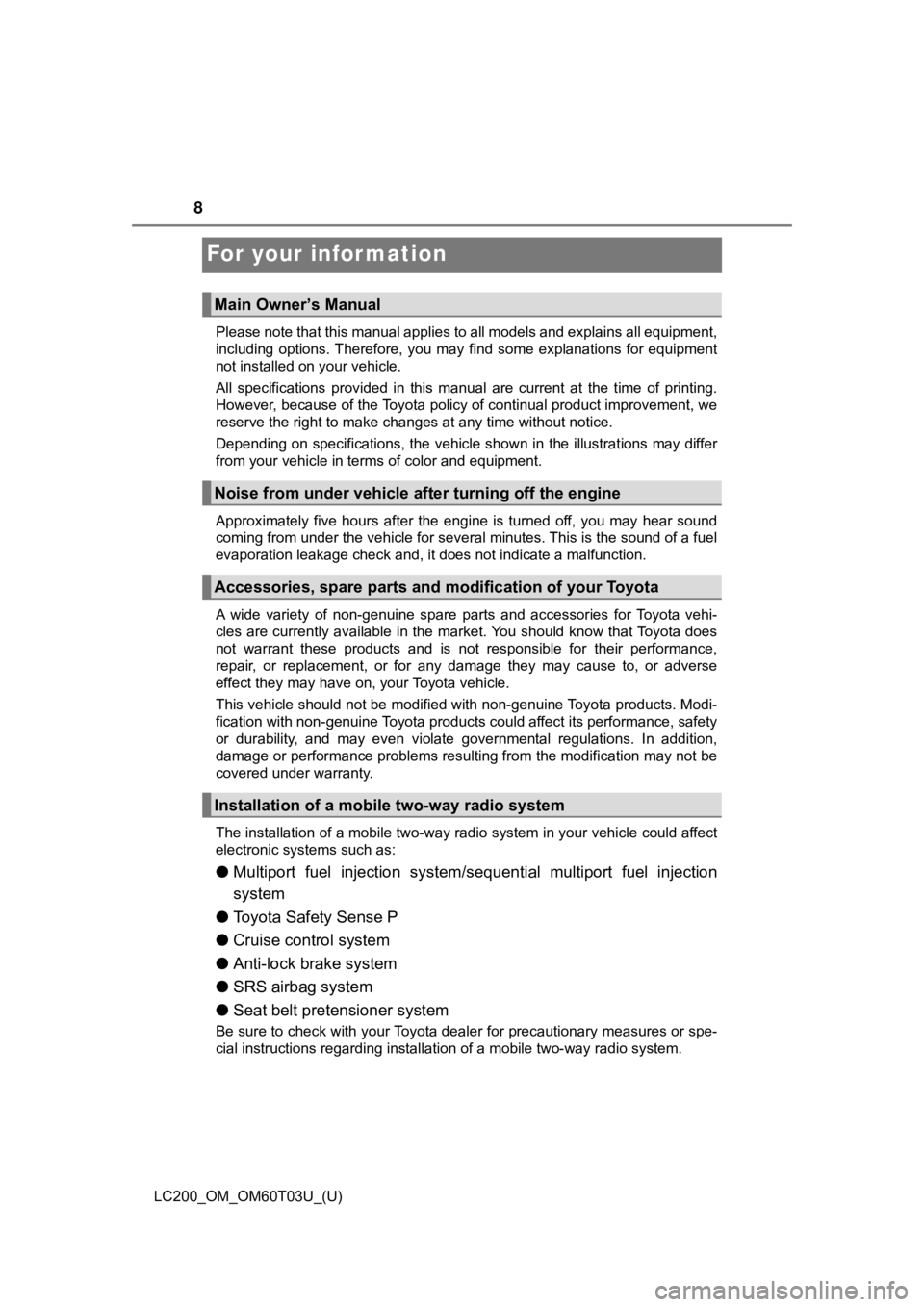
8
LC200_OM_OM60T03U_(U)
For your infor mation
Please note that this manual applies to all models and explains all equipment,
including options. Therefore, you may find some explanations fo r equipment
not installed on your vehicle.
All specifications provided in this manual are current at the t ime of printing.
However, because of the Toyota policy of continual product improvement, we
reserve the right to make changes at any time without notice.
Depending on specifications, the vehicle shown in the illustrat ions may differ
from your vehicle in terms of color and equipment.
Approximately five hours after the engine is turned off, you ma y hear sound
coming from under the vehicle for several minutes. This is the sound of a fuel
evaporation leakage check and, it does not indicate a malfunction.
A wide variety of non-genuine spare parts and accessories for T oyota vehi-
cles are currently available in the market. You should know tha t Toyota does
not warrant these products and is not responsible for their per formance,
repair, or replacement, or for any damage they may cause to, or adverse
effect they may have on, your Toyota vehicle.
This vehicle should not be modified with non-genuine Toyota pro ducts. Modi-
fication with non-genuine Toyota products could affect its perf ormance, safety
or durability, and may even violate governmental regulations. In addition,
damage or performance problems resulting from the modification may not be
covered under warranty.
The installation of a mobile two-way radio system in your vehic le could affect
electronic systems such as:
● Multiport fuel injection system /sequential multiport fuel injec tion
system
● Toyota Safet y Sense P
● Cruise control system
● Anti-lock brake system
● SRS airbag system
● Seat belt pret ensioner system
Be sure to check with your Toyota dealer for precautionary meas ures or spe-
cial instructions regarding instal lation of a mobile two-way radio system.
Main Owner’s Manual
Noise from under vehicle afte r turning off the engine
Accessories, spare parts and m odification of your Toyota
Installation of a mobile two-way radio system
Page 11 of 632
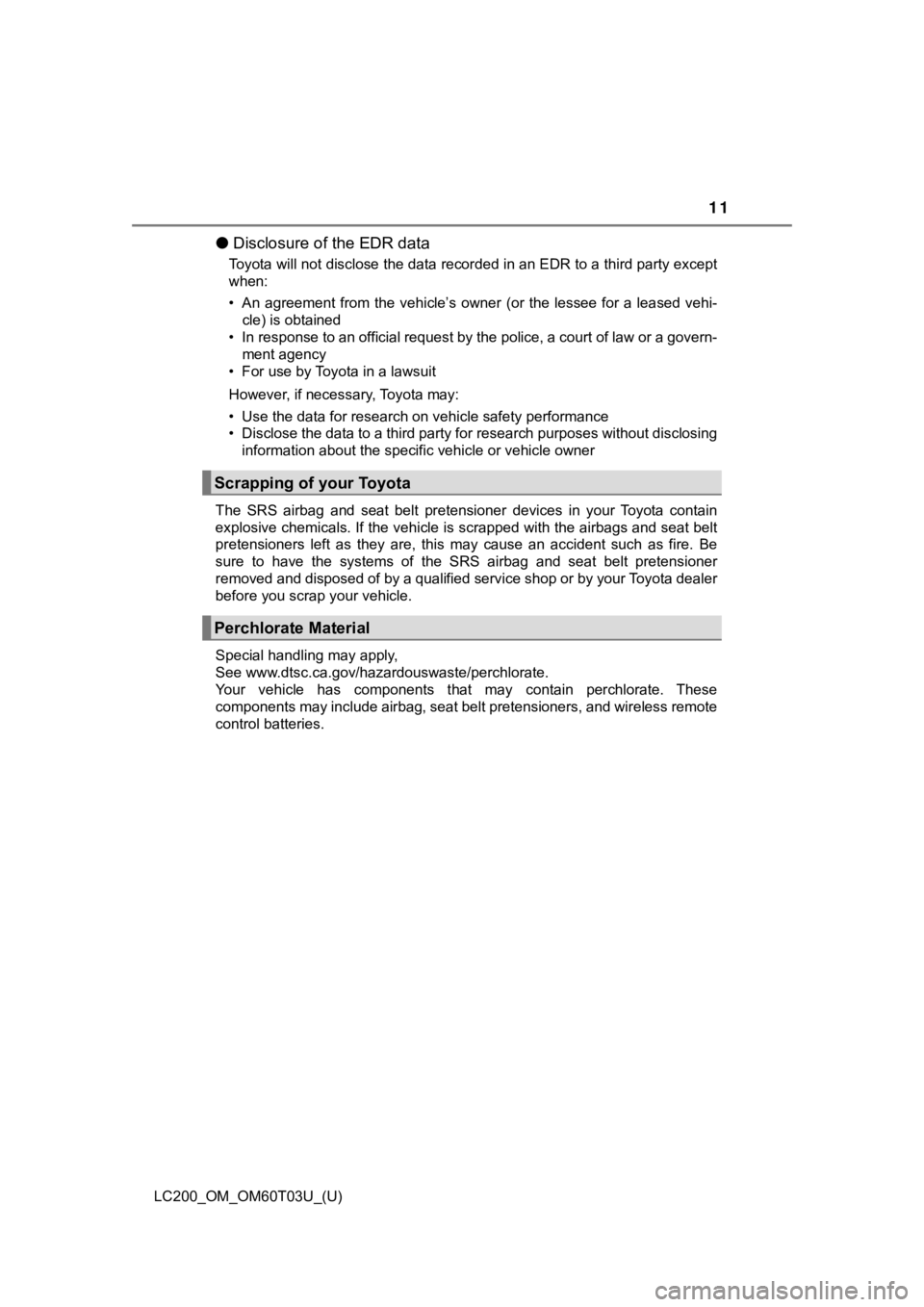
LC200_OM_OM60T03U_(U)
11
● Disclosure of the EDR data
Toyota will not disclose the data recorded in an EDR to a third party except
when:
• An agreement from the vehicle’s owner (or the lessee for a lea sed vehi-
cle) is obtained
• In response to an official request by the police, a court of l aw or a govern-
ment agency
• For use by Toyota in a lawsuit
However, if necessary, Toyota may:
• Use the data for research on vehicle safety performance
• Disclose the data to a third party for research purposes witho ut disclosing
information about the specific vehicle or vehicle owner
The SRS airbag and seat belt pretensioner devices in your Toyot a contain
explosive chemicals. If the vehicle is scrapped with the airbag s and seat belt
pretensioners left as they are, this may cause an accident such as fire. Be
sure to have the systems of the SRS airbag and seat belt preten sioner
removed and disposed of by a qualified service shop or by your Toyota dealer
before you scrap your vehicle.
Special handling may apply,
See www.dtsc.ca.gov/hazardouswaste/perchlorate.
Your vehicle has components that may contain perchlorate. These
components may include airbag, seat belt pretensioners, and wir eless remote
control batteries.
Scrapping of your Toyota
Perchlorate Material
Page 24 of 632
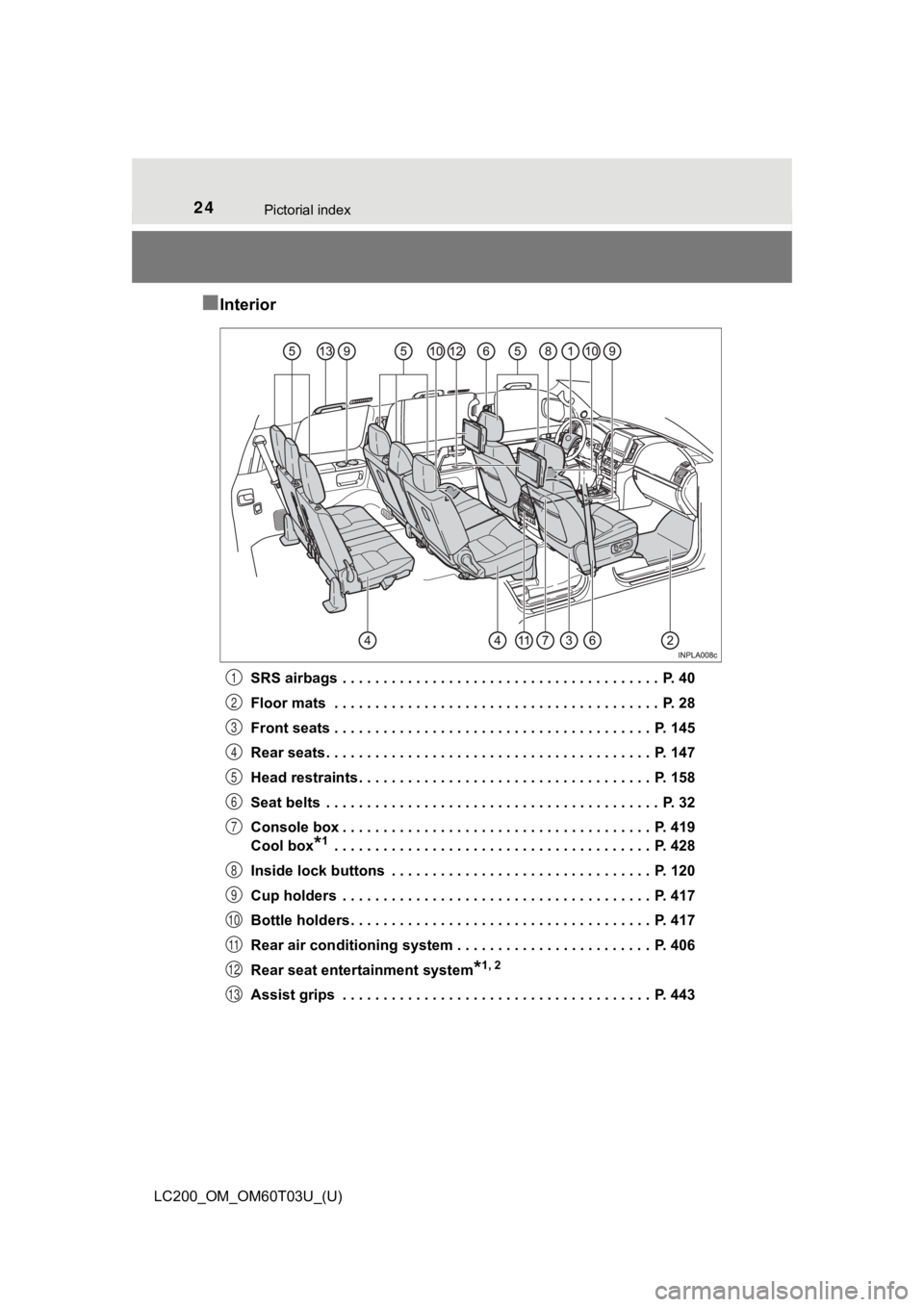
24Pictorial index
LC200_OM_OM60T03U_(U)
■Interior
SRS airbags . . . . . . . . . . . . . . . . . . . . . . . . . . . . . . . . . . . . . . . P. 40
Floor mats . . . . . . . . . . . . . . . . . . . . . . . . . . . . . . . . . . . . . . . . P. 28
Front seats . . . . . . . . . . . . . . . . . . . . . . . . . . . . . . . . . . . . . . . P. 145
Rear seats . . . . . . . . . . . . . . . . . . . . . . . . . . . . . . . . . . . . . . . . P. 147
Head restraints . . . . . . . . . . . . . . . . . . . . . . . . . . . . . . . . . . . . P. 158
Seat belts . . . . . . . . . . . . . . . . . . . . . . . . . . . . . . . . . . . . . . . . . P. 32
Console box . . . . . . . . . . . . . . . . . . . . . . . . . . . . . . . . . . . . . . P. 419
Cool box
*1 . . . . . . . . . . . . . . . . . . . . . . . . . . . . . . . . . . . . . . . P. 428
Inside lock buttons . . . . . . . . . . . . . . . . . . . . . . . . . . . . . . . . P. 120
Cup holders . . . . . . . . . . . . . . . . . . . . . . . . . . . . . . . . . . . . . . P. 417
Bottle holders . . . . . . . . . . . . . . . . . . . . . . . . . . . . . . . . . . . . . P. 417
Rear air conditioning system . . . . . . . . . . . . . . . . . . . . . . . . P. 406
Rear seat entertainment system
*1, 2
Assist grips . . . . . . . . . . . . . . . . . . . . . . . . . . . . . . . . . . . . . . P. 443
1
2
3
4
5
6
7
8
9
10
11
12
13
Page 27 of 632

27
LC200_OM_OM60T03U_(U)
For safety and security1
1-1. For safe useBefore driving ...................... 28
For safe driving ................... 30
Seat belts ............................ 32
SRS airbags ........................ 40
Front passenger occupant classification system ......... 52
Exhaust gas precautions..... 58
1-2. Child safety Riding with children ............. 59
Child restraint systems........ 60
1-3. Emergency assistance Safety Connect ................... 79
1-4. Theft deterrent system Engine immobilizer system .............................. 85
Alarm................................... 87
Page 40 of 632
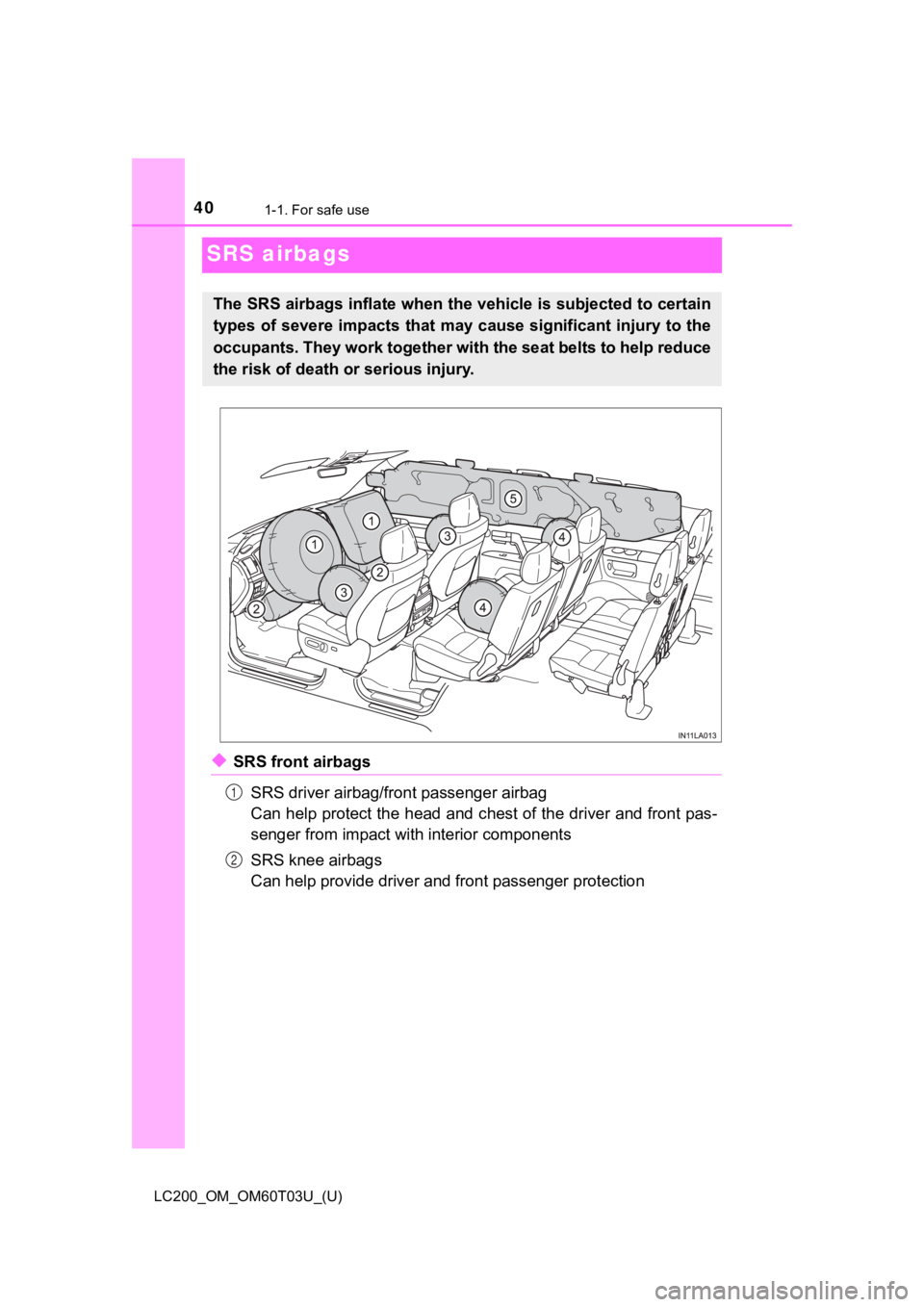
401-1. For safe use
LC200_OM_OM60T03U_(U)
SRS airbags
◆SRS front airbagsSRS driver airbag/front passenger airbag
Can help protect the head and c hest of the driver and front pas-
senger from impact with interior components
SRS knee airbags
Can help provide driver and front passenger protection
The SRS airbags inflate when th e vehicle is subjected to certain
types of severe impacts that may cause significant injury to th e
occupants. They work together wit h the seat belts to help reduce
the risk of death or serious injury.
1
2
Page 41 of 632

411-1. For safe use
LC200_OM_OM60T03U_(U)
1
For safety and security
◆SRS side and curtain shield airbags
SRS front side airbags
Can help protect the torso o f the front seat occupants
SRS rear side airbags
Can help protect the torso of occupants in the second outboard
seats
SRS curtain sh ield airbags
● Can help protect primarily the head of occupants in the out-
board seats
● Can help prevent the occupants from being thrown from the
vehicle in the event of vehicle rollover
3
4
5
Page 42 of 632
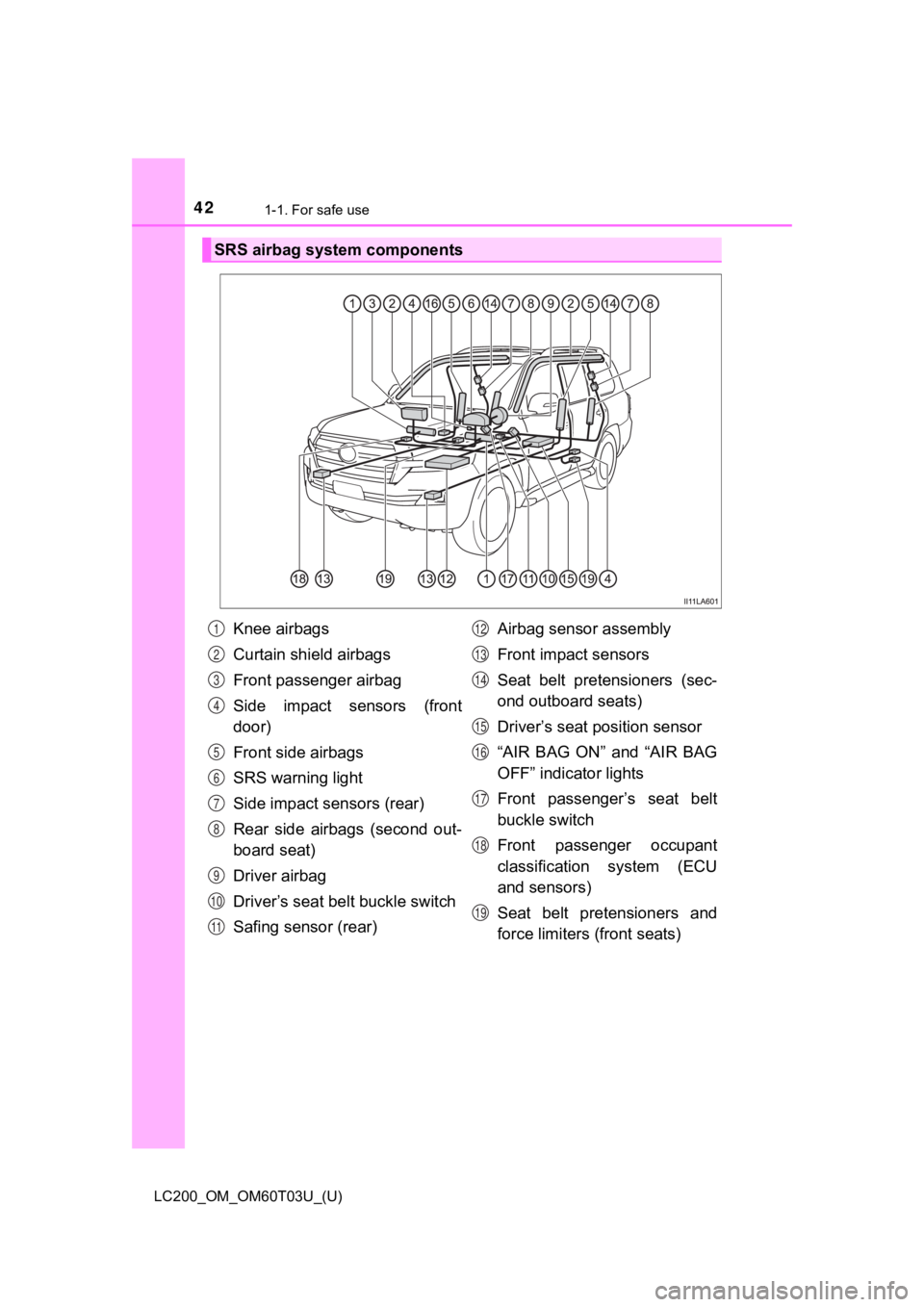
421-1. For safe use
LC200_OM_OM60T03U_(U)
SRS airbag system components
Knee airbags
Curtain shield airbags
Front passenger airbag
Side impact sensors (front
door)
Front side airbags
SRS warning light
Side impact sensors (rear)
Rear side airbags (second out-
board seat)
Driver airbag
Driver’s seat belt buckle switch
Safing sensor (rear)Airbag sensor assembly
Front impact sensors
Seat belt pretensioners (sec-
ond outboard seats)
Driver’s seat position sensor
“AIR BAG ON” and “AIR BAG
OFF” indicator lights
Front passenger’s seat belt
buckle switch
Front passenger occupant
classification system (ECU
and sensors)
Seat belt pretensioners and
force limiters (front seats)1
2
3
4
5
6
7
8
9
10
11
12
13
14
15
16
17
18
19
Page 43 of 632
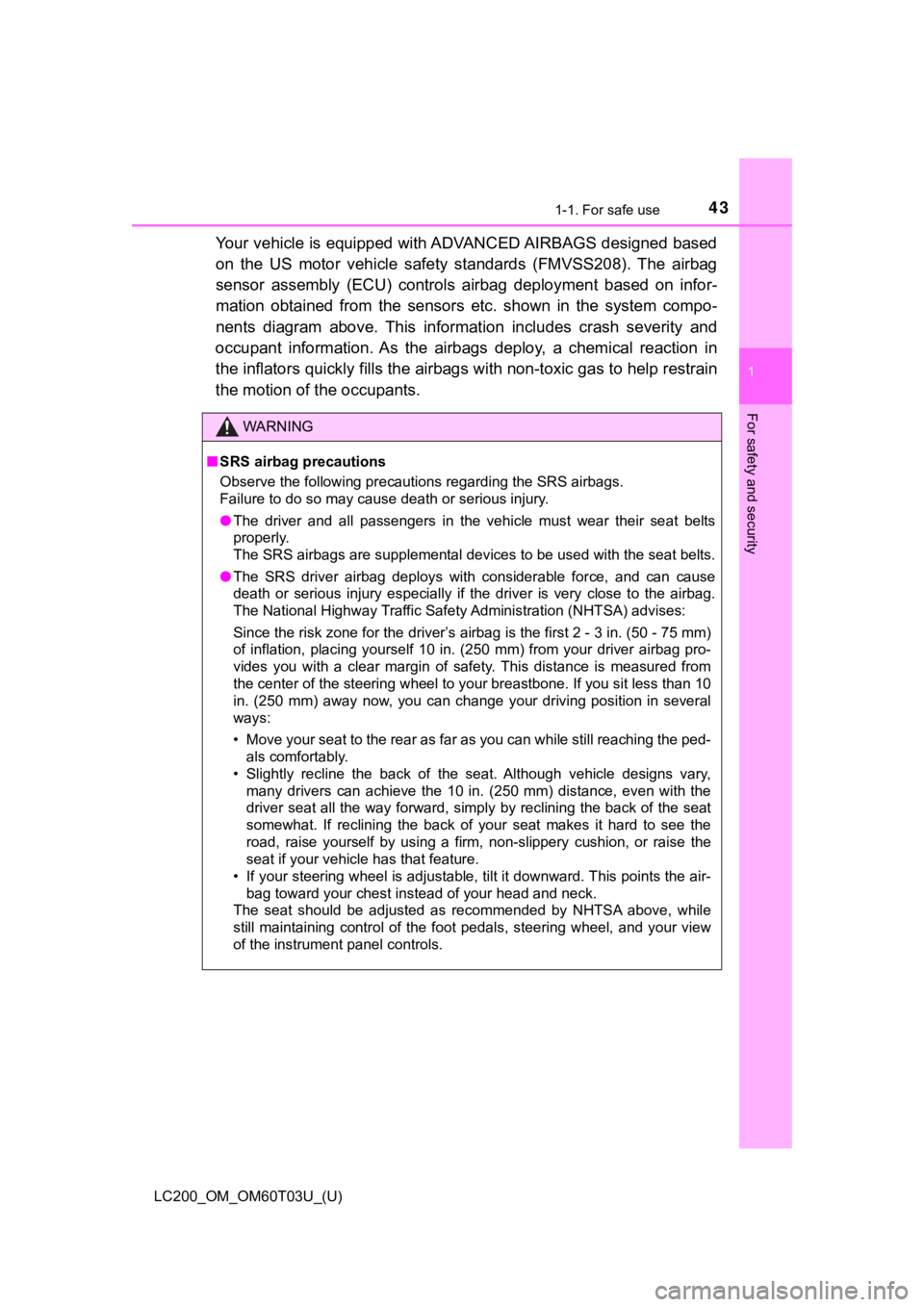
431-1. For safe use
LC200_OM_OM60T03U_(U)
1
For safety and security
Your vehicle is equipped with ADVANCED AIRBAGS designed based
on the US motor vehicle safety standards (FMVSS208). The airbag
sensor assembly (ECU) controls airbag deployment based on infor-
mation obtained from the sensors etc. shown in the system compo -
nents diagram above. This informat ion includes crash severity and
occupant information. As the airbags deploy, a chemical reactio n in
the inflators quickly fills the airbags with non-toxic gas to h elp restrain
the motion of t he occupants.
WARNING
■SRS airbag precautions
Observe the following precautions regarding the SRS airbags.
Failure to do so may cause death or serious injury.
● The driver and all passengers in the vehicle must wear their se at belts
properly.
The SRS airbags are supplemental devices to be used with the se at belts.
● The SRS driver airbag deploys with considerable force, and can cause
death or serious injury especially if the driver is very close to the airbag.
The National Highway Traffic Safety Administration (NHTSA) advi ses:
Since the risk zone for the driver’s airbag is the first 2 - 3 in. (50 - 75 mm)
of inflation, placing yourself 10 in. (250 mm) from your driver airbag pro-
vides you with a clear margin of safety. This distance is measured from
the center of the steering wheel to your breastbone. If you sit less than 10
in. (250 mm) away now, you can change your driving position in several
ways:
• Move your seat to the rear as far as you can while still reach ing the ped-
als comfortably.
• Slightly recline the back of the seat. Although vehicle design s vary,
many drivers can achieve the 10 in. (250 mm) distance, even wit h the
driver seat all the way forward, simply by reclining the back o f the seat
somewhat. If reclining the back of your seat makes it hard to s ee the
road, raise yourself by using a firm, non-slippery cushion, or raise the
seat if your vehicle has that feature.
• If your steering wheel is adjustable, tilt it downward. This points the air-
bag toward your chest instead of your head and neck.
The seat should be adjusted as recommended by NHTSA above, whil e
still maintaining control of the foot pedals, steering wheel, and your view
of the instrument panel controls.
Page 44 of 632
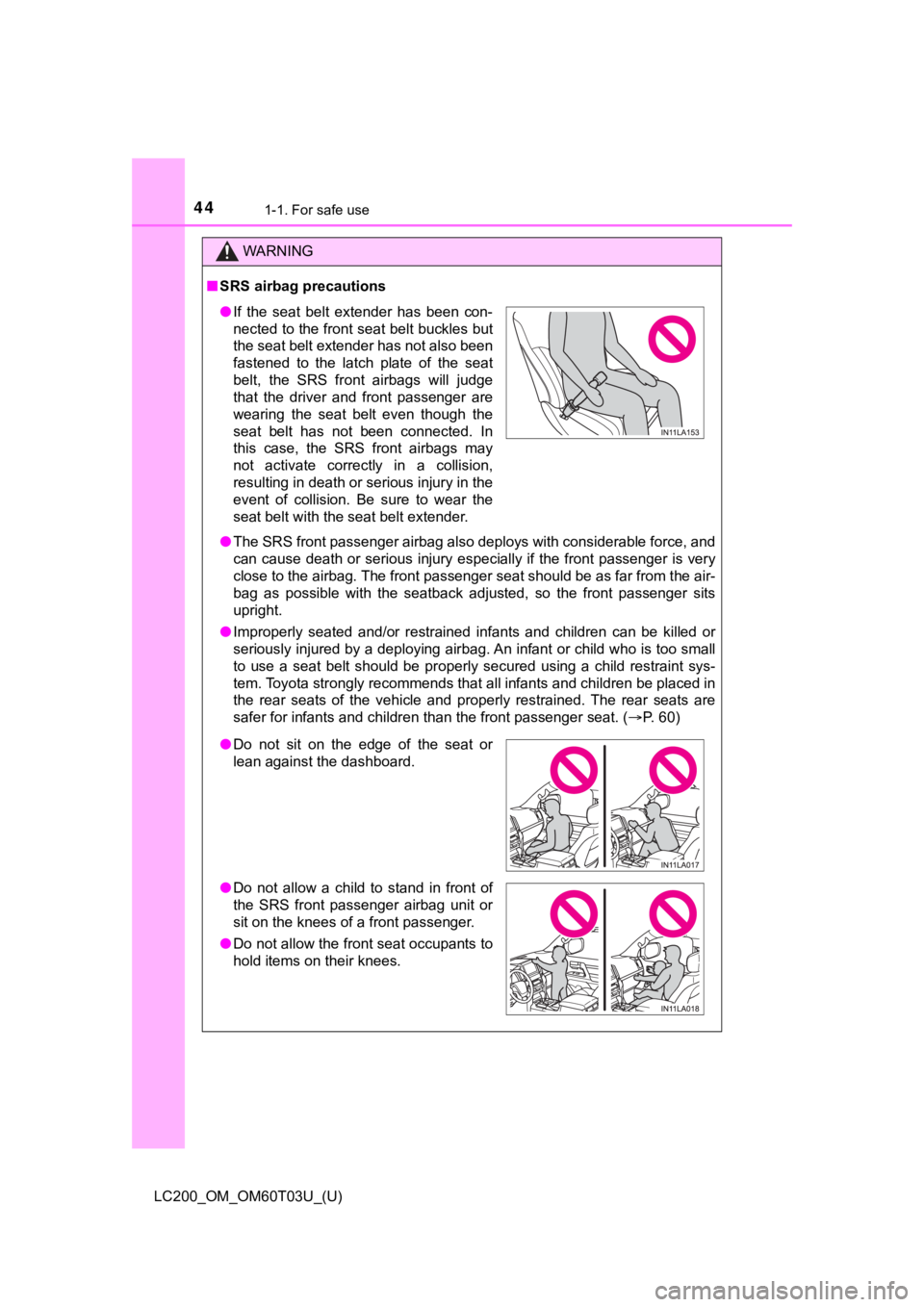
441-1. For safe use
LC200_OM_OM60T03U_(U)
WARNING
■SRS airbag precautions
● The SRS front passenger airbag also deploys with considerable f orce, and
can cause death or serious injury especially if the front passe nger is very
close to the airbag. The front passenger seat should be as far from the air-
bag as possible with the seatback adjusted, so the front passenger sits
upright.
● Improperly seated and/or restrained infants and children can be killed or
seriously injured by a deploying airbag. An infant or child who is too small
to use a seat belt should be properly secured using a child restraint sys-
tem. Toyota strongly recommends that all infants and children b e placed in
the rear seats of the vehicle and properly restrained. The rear seats are
safer for infants and children than the front passenger seat. ( P. 60)
●If the seat belt extender has been con-
nected to the front seat belt buckles but
the seat belt extender has not also been
fastened to the latch plate of the seat
belt, the SRS front airbags will judge
that the driver and front passenger are
wearing the seat belt even though the
seat belt has not been connected. In
this case, the SRS front airbags may
not activate correctly in a collision,
resulting in death or serious injury in the
event of collision. Be sure to wear the
seat belt with the seat belt extender.
●Do not sit on the edge of the seat or
lean against the dashboard.
● Do not allow a child to stand in front of
the SRS front passenger airbag unit or
sit on the knees of a front passenger.
● Do not allow the front seat occupants to
hold items on their knees.